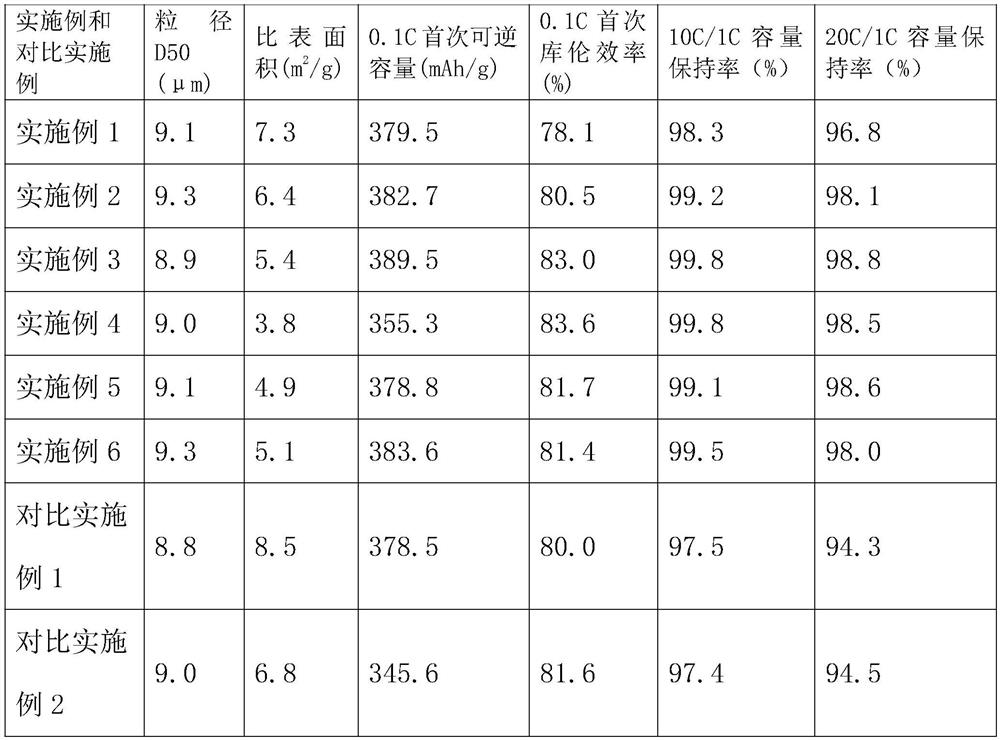High-capacity spherical hard carbon anode material coated with graphene on the surface
A graphene-coated, negative electrode material technology, applied in the field of lithium-ion batteries, can solve the problems of large irreversible capacity of hard carbon, limit the wide application of hard carbon, low initial efficiency, etc., and achieve excellent electrochemical performance, low cost, and product properties. stable effect
- Summary
- Abstract
- Description
- Claims
- Application Information
AI Technical Summary
Problems solved by technology
Method used
Image
Examples
Embodiment 1
[0025] (1) Under stirring, add coumarone resin, paraformaldehyde and p-toluenesulfonic acid into the reaction kettle with a mass ratio of 20:12:1, mix evenly, and heat up to 180°C under nitrogen atmosphere and stirring conditions for exchange Copolymerize for 4 hours, cool down to room temperature and discharge to obtain a polymerized reactant, and ball mill and sieve the polymerized reactant to obtain a hard carbon precursor with a D50 particle size of 10-15 μm;
[0026] (2) The hard carbon precursor was treated with dimethyl silicone oil at 250°C to prepare the crude polymer microspheres, cooled to room temperature and discharged, washed with ethanol to remove the silicone oil on the surface of the crude polymer microspheres, and then dried to obtain polymer microspheres;
[0027] (3) Polymer microspheres were oxidized at 260° C. for 1 h in an air atmosphere, cooled to room temperature, and discharged to obtain infusible microspheres; then they were loaded into a well-type f...
Embodiment 2
[0031] (1) Add coumarone resin, paraformaldehyde and p-toluenesulfonic acid to the reaction kettle with a mass ratio of 20:12:1 under stirring, mix well, and heat up to 180°C under nitrogen atmosphere and stirring conditions for crosslinking Polymerize for 4 hours, cool down to room temperature and discharge to obtain a polymerized reactant, and ball mill and sieve the polymerized reactant to obtain a hard carbon precursor with a D50 particle size of 10-15 μm;
[0032] (2) The hard carbon precursor was treated with dimethyl silicone oil at 250°C to obtain the crude polymer microspheres, cooled to room temperature and discharged, washed with ethanol to remove the silicone oil on the surface of the crude polymer microspheres, and then dried to obtain polymer microspheres;
[0033] (3) The polymer microspheres were oxidized at 260°C for 1 hour in an air atmosphere, cooled to room temperature, and discharged to obtain infusible microspheres; they were then put into a well-type fur...
Embodiment 3
[0037](1) Add coumarone resin, paraformaldehyde and p-toluenesulfonic acid to the reaction kettle with a mass ratio of 20:12:1 under stirring, mix well, and heat up to 180°C under nitrogen atmosphere and stirring conditions for crosslinking Polymerize for 4 hours, cool down to room temperature and discharge to obtain a polymerized reactant, and ball mill and sieve the polymerized reactant to obtain a hard carbon precursor with a D50 particle size of 10-15 μm;
[0038] (2) The hard carbon precursor was treated with dimethyl silicone oil at 250°C to obtain the crude polymer microspheres, cooled to room temperature and discharged, and the silicone oil on the surface of the crude polymer microspheres was washed with ethanol and dried to obtain polymer microspheres;
[0039] (3) Polymer microspheres were oxidized at 260°C for 1 hour in an air atmosphere, cooled to room temperature, and discharged to obtain infusible microspheres; they were then put into a well-type furnace and heat...
PUM
| Property | Measurement | Unit |
|---|---|---|
| particle size | aaaaa | aaaaa |
| particle size | aaaaa | aaaaa |
| density | aaaaa | aaaaa |
Abstract
Description
Claims
Application Information
 Login to View More
Login to View More - R&D
- Intellectual Property
- Life Sciences
- Materials
- Tech Scout
- Unparalleled Data Quality
- Higher Quality Content
- 60% Fewer Hallucinations
Browse by: Latest US Patents, China's latest patents, Technical Efficacy Thesaurus, Application Domain, Technology Topic, Popular Technical Reports.
© 2025 PatSnap. All rights reserved.Legal|Privacy policy|Modern Slavery Act Transparency Statement|Sitemap|About US| Contact US: help@patsnap.com

